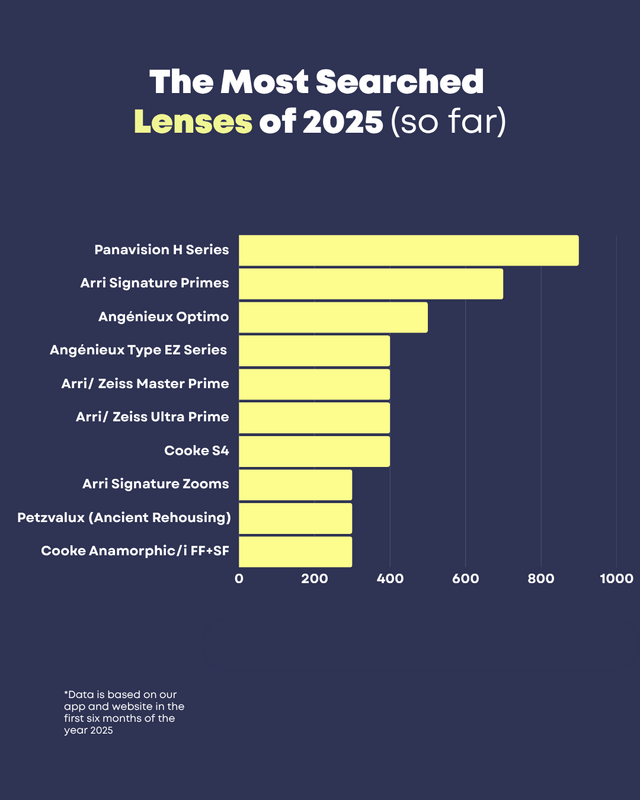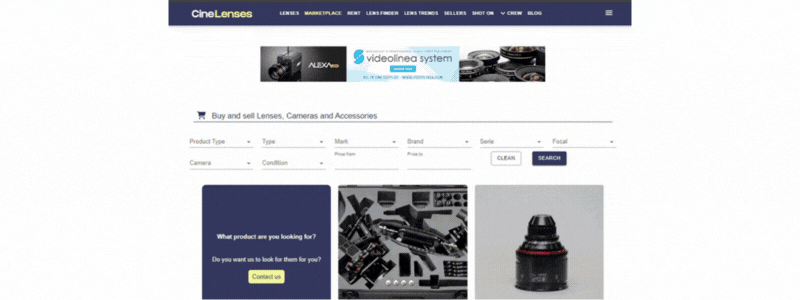Lens Trends 2025: The 10 Most Searched Cinema Lenses (so far) 7/24/2025, 12:00:00 AM

The Most Searched Lenses of 2025 (So Far): What Filmmakers Are Looking For and Where to Find Them
Thanks to "Lens Trends", CineLenses reveals which cinema lenses are in highest demand globally. Whether you're just curious, building a gear list or wondering if your old set is worth something, this ranking might just change the way you think about gear.
1. Panavision H Series
-
Type: Spherical Lenses
-
Era: It was launched in the 1970s
-
Notable Usage: “Dune” (2021), Ford v Ferrari (2019), Mission: Impossible – Dead Reckoning Part One (2023)
-
Why it’s popular: Soft roll-off, flattering skin tones, classic portrait look from vintage glass

2. ARRI Signature Primes
-
Type: Spherical Primes
-
Era: Launched circa 2020 (approximate)
-
Notable Usage: 1917 (2019), Enola Holmes (2020), Emma (2020)
-
Why filmmakers love them: Lightweight magnesium barrels with ARRI’s renowned optical quality

3. Angénieux Optimo
-
Type: Zooms
-
Era: Decades-long series (year varies by model)
-
Notable Usage: Ad Astra (2019),Cold War (2018)
-
Why it stands out: Flexible zoom range with cinematic style and consistent performance

4. Angénieux Type EZ Series
-
Type: Zooms (EZ = Easy Zoom)
-
Era: Launched circa 2016 (approximate)
-
Noteworthy Usage: An Officer and a Spy (2019), The Last Thing he Wanted (2020)
-
Why popular: Offers smooth, visually pleasing zoom mechanics ideal for run-and-gun setups

5. ARRI/Zeiss Master Prime
-
Type: Spherical Primes
-
Era: mid-2000s
-
Notable Usage: Truman (2015), Skyfall (2012), Enigma (2014)
-
Why filmmakers choose it: Super-fast T-stops (T1.3–1.9), extreme sharpness, “Master Prime look”

6. ARRI/Zeiss Ultra Prime
-
Type: Spherical Primes
-
Era: They were introduced to the market in 1999
-
Notable Usage: Venom (2018), Blade Runner 2045 (2017), Fire Will Come (2019)
-
Overview: Vice versa of Master Primes—classic sharp primes for broader use, excellent value-performance

7. Cooke S4
-
Type: Spherical Primes
-
Era: Launched 1998
-
Notable Usage: The Two Popes (2019), Into the Wild (2007), Mientras duermes (2011)
-
Distinctive trait: Warm, pleasing bokeh, lower contrast, organic skin tone, the “Cooke Look”

8. ARRI Signature Zooms
-
Type: Modern Zooms
-
Era: Post-2020
-
Notable Usage: Bridgerton (2020), The Flash (2023)
-
Why trending: Combines optical quality with convenience, shooters appreciate prime-like sharpness in a zoom package

9. Petzvalux (Ancient Rehousing)
-
Type: Vintage Spherical (re-housed)
-
Era: Petzval lenses, in their original design, date back to 1840. The "rehousing" of these lenses has been carried out in more recent times, such as 2020 for some models.
-
Usage data: Unknown
-
Appeal: Unique “Petzval swirl” bokeh and antique character for stylized filming
10. Cooke Anamorphic/i FF+ SF
-
Type: Anamorphic Primes
-
Era: Launched 2018
-
Usage data: The Animal Kingdom (2023), Lost in the Night (2023)
-
Highlights: Cinematic widescreen look (2.39:1), Cooke flair, ideal flare characteristics and shallow depth of field

What Is Lens Trends?
"Lens Trends" is a powerful tool by CineLenses that tracks the most searched lenses across our platform by day, month and year. It's like "Google Trends", but exclusively for professional cinema lenses. This isn't guesswork, it's real-time data from thousands of filmmakers.
Now that we’ve passed the first half of 2025, here’s the list everyone wants to see.
Since January to date, CineLenses has received a total of 1,609,662 visits on the App + Website.

Want One of These? Or Have One to Sell?
If you spotted a lens from the list and thought “I need that,” or “I have that just sitting on a shelf,” you're in the right place.
On the CineLenses Marketplace, you can buy and sell lenses, cameras and accessories. We connect professional buyers and sellers worldwide, no fluff, just real gear for real productions.
Lens Trends gives you the insight. The Marketplace gives you the action.

Copyright © Cinelenses S.L 2026.







